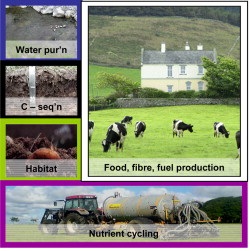Soil functions refer to soil based ecosystem services: an overarching concept referring to one (out of five, following Schulte et al., 2014) elemental aspect of the soil system that contributes to the generation of goods and services ( LANDMARK GLOSSARY).

Primary productivity (white box)
Water purification and regulation (blue box)
Carbon sequestration and regulation (black box)
Provision of functional and intrinsic biodiversity (green box)
Provision and cycling of nutrients (purple box)
If you would like to consult previous literature on soil functions: Haygarth and Ritz, 2009; Creamer and Holden, 2010; Bouma et al., 2012; Rutgers et al., 2012; Schulte et al.,2014.
All soils perform these functions simultaneously, but both the extent and the relative composition of this functionality depends upon pedological, physical, chemical and biological soil properties.
The LANDMARK team developed a comprehensive science-based framework for understanding and quantifying soil functions. Each soil function has a definition and it is described by a set of attributes visually represented by a DEXi tree.
| Colour code | Soil functions | Definition | PAPER | |
| Primary productivity | The capacity of a soil to produce plant biomass for human use, providing food, feed, fiber and fuel within natural or managed ecosystem boundaries |
Development of an Agricultural Primary Productivity Decision Support Model: A Case Study in France |
||
| |
Water purification and regulation | The capacity of a soil to remove harmful compounds from the water that it holds and to receive, store and conduct water for subsequent use and the prevention of both prolonged droughts and flooding and erosion | ||
| Climate regulation and carbon sequestration | The capacity of a soil to reduce the negative impact of increased greenhouse gas (i.e., CO2, CH4, and N2O) emissions on climate |
|
Van De Broek, Marijn, et al (2019) Assessing the Climate Regulation Potential of Agricultural Soils Using a Decision Support Tool Adapted to Stakeholders’ Needs and Possibilitis and its publication tree | |
| Soil biodiversity and habitat provisioning | The multitude of soil organisms and processes, interacting in an ecosystem, making up a significant part of the soil’s natural capital, providing society with a wide range of cultural services and unknown services |
|
Van Leeuwen, Jeroen P., et al (2019) Modelling of Soil Functions for Assessing Soil Quality: Soil Biodiversity and Habitat Provisioning and its publication tree | |
| Provision and cycling of nutrients | The capacity of a soil to receive nutrients in the form of by-products, to provide nutrients from intrinsic resources or to support the acquisition of nutrients from air or water, and to effectively carry over these nutrients into harvested crops |
|
Schröder,J.J., et al (2017) The elusive role of soil quality in nutrient cycling: A review and its publication tree |
Functional Land Management is a conceptual framework for optimising the supply of soil-based ecosystem services, grouped together in these five overarching soil functions, to the demands at a range of spatial scales, with a view to simultaneously meeting agronomic and environmental policy objectives (Schulte et al., 2014; O’Sullivan et al., 2015).
Analogous to the expression Genotype x Environment x Management (G x E x M) approach commonly applied in the field of crop production, soil functionality depends on soil type “S” (i.e. diagnostic features – intrinsic and dynamic ones), environment “E” (climate, weather, slope, land use, etc. ) and soil management “M” acknowledging that soil functions are never uniquely determined by just one of these three factors.
S x E x M
For example, the impact of land use on the relative composition of soil functions may be illustrated as follows (Schulte et al., 2014) :











